All you need to know about your products!

| 3DNews Vendor Reference English Resource - All you need to know about your products! |
||||||
 |
||||||
|
|
||||||
Tests of coolers - ASUS, Scythe, and Cooler MasterAuthor:Date: 06/06/2006 ASUS Silent SquareOver a year ago, ASUS presented its first cooler StarIce aimed at PC enthusiasts. In fact, the phrase "its" is taken be taken in quotation marks since the cooler was too similar to the model ThermalTake Beetle and most likely was manufactured as an OEM order. It is also hardly aimed at PC enthusiasts because the cooling efficiency of StarIce was low and the noise level too high. As a result, the cooler hasn't gained popularity,and ASUS have taken a timeout for a year. In 2006, the company presented the new model Silent Square with ten heat pipes! The cooler is package in a cardboard box with transparent windows and a handle to carry it around: 
Inside it, apart from the cooler itself, we found a kit of fasteners, fastening frames for various platforms, an enforcement plate for a motherboard, a tub of thermo paste, as well as a brief installation guide. 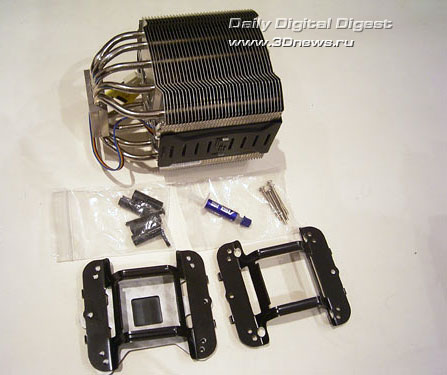
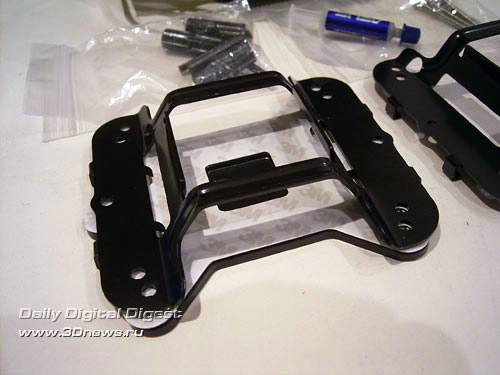
The design of the cooler is rather simple: the aluminum base is linked with a radiator using heat pipes (10 pieces); the radiator is made up of two parts between which there is a 92 mm fan of 1800 RPM rotational speed. It produces 32.25 CFM air flow, with the noise level not exceeding 18 dBa. We should note straight off that the cooler operates almost noiselessly, which confirms the declared specifications. 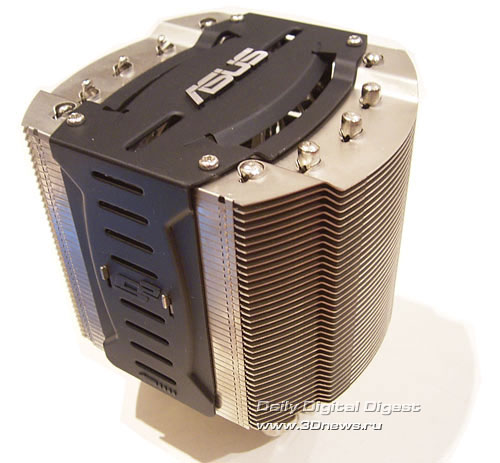
The fan is inside a plastic package, which does not let the user to replace it with a more powerful (e.g. that in Scythe Mine). Inside package, there is a couple of blue LEDs which provide good illumination to the cooler. 
As our tests showed, the cooler's efficiency is high enough and the noise level is minimum. So most users will find the specifications of this cooler more than satisfactory. 
The processing quality of the base is high enough, but is still to far to the mirror surface: 
Of note are the rather massive dimensions of ASUS Silent Square. Its length is 140 mm, width - 115 mm, and the height is 140 mm. As a result, during its installation there may come up various issues related to blocking of other system components (e.g., memory modules, a fan on the chipset or a video card). The cooler weighs 656 g. 
Actually, issues with its installation came up at quite an unexpected place. In particular, the enforcement plate did not fit tightly to the motherboard (ASUS P5WD2 Premium) because of traces left by the solder. 
In fact, this issue is not big one and is solved with a rubber washer and longer screws. But the second issue proved much more critical: we received a specimen for the press, and its package bundle lacked a fastening frame for LGA775 (but there were two pieces for AMD platform). So we made the following fastener with materials at hand: 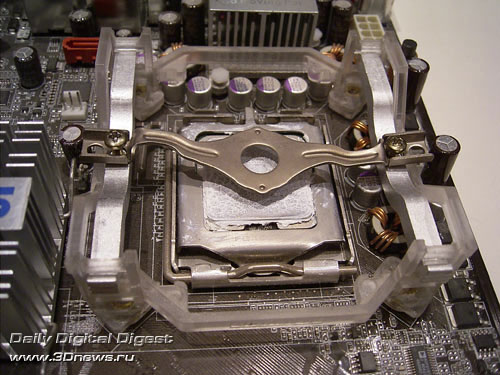
Since the fastener differs from the factory-made, the results of tests for ASUS Silent Square cooler are presented solely for estimation, and we'll come back to tests of this product in further materials. Despite the apprehension, we successfully fitted the cooler and none of the critical components was blocked: 
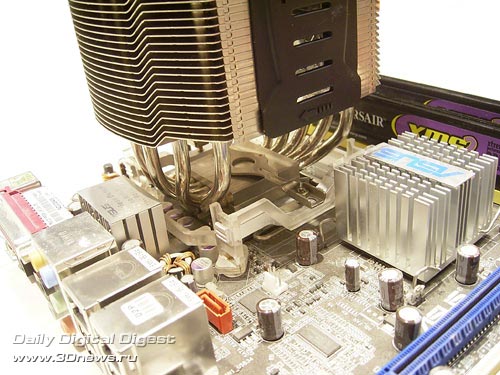
The retail price of the cooler is over 55$ which may seem too much, at first glance. So, we'll see the totals of the review to find out how justified the price was. Pros:
Cons:
Scythe Ninja+Two months ago, we reviewed the cooler Scythe Ninja which left quite pleasant impression. Today, we are testing the modified version Ninja+. The first thing to note is there are no changes - in the package design,  
and in the package bundle which contains a kit of fasteners with a special wrench, a plastic frame for AMD motherboards, an enforcement plate for LGA775 boards, a pack of thermo paste, as well as brief installation guide. 
This time, the box has somehow gone up in size because the cooler is now equipped with a 120 mm fan. 
Here are its brief specifications: rotational speed - 1200 rpm, the generated air flow = 23.5 CFM. Surprisingly, the fan operates almost noiselessly! We haven't found any changes to the radiator design, nor in the cumbersome fastening procedure. 
The radiator's dimensions have remained unchanged: the length is 110 mm, width - 110 mm, and the height is 150 mm. However, the overall weight of the cooler has gone up due to the fan and amounts to 815 g. The fastener of the fan is universal, which allows the user to replace it with any 120 mm fan. The high efficiency of the Ninja+ radiator allows the buyer to choose either the performance-mode fan (noisy) or confine to a low-speed and quiet fan. The design of the radiator is rather interesting but in general it is traditional. 12 heat pipes extend out of the copper base - 3 on each side. 
Besides, the base has an additional kit of fins which is supposed to improve the cooling efficiency. 
On the heat pipes there are 23 fine aluminum plates threaded, which are of quite intricate shape (as can be seen on the following photos). 
The processing quality of the base is high enough, but is still to far to the mirror surface: 
Anyway, the fan can be installed on any of the 4 sides of the radiator, which allows the user to avoid potential conflicts. 
Unfortunately, the major issue of Scythe Ninja+ is about the very inconvenient scheme of fastening on LGA775 motherboards. To do the operation, the following has to be done simultaneously: hold the motherboard, hold the metal enforcement plate (thus aligning the holes with the assembly holes on the board), hold the plate with hangers on the other side of the board (again aligning the holes), run the screw through and tighten it with a screwdriver. The situation is made worse by plastic washers (they prevent the motherboard surface from scratches) which are always slipping and get lost. 

By the way, nothing prevents from using the Scythe Ninja+ without a fan at all. However, this mode of operation is applicable only to AMD processors running at reduced frequency and supply voltage. But we wouldn't recommend trying these experiments since in this case the power supply module of the board may overheat (owners of water-based cooling systems must be well aware of this problem). Pros:
Cons:
Note that the retail price of Scythe Ninja+ is somewhere about 45 $. A bit too much, but the high cooling efficiency allows us to recommend this product for purchase. Scythe Kamaboko-ZKamaboko-Z is a modified version of the Kamaboko cooler which we reviewed almost a year ago. 
The scheme of fastening the cooler hasn't changed at all and fully meets the fastening of Scythe Ninja+. 
The design improvement is about use of two heat pipes which link the base to the upper part of the radiator. 
The cooler itself looks like this: 
Another serious improvement is in that the plates of the upper part of the radiator are made of copper. 
The cooler's overall dimensions are: the length is 96 mm, width - 94 mm, and the height 92 mm. 
Note that the fan is powered via a Molex connector, and the rotational speed is determined with special additional connector. Besides, the user can adjust the speed with a regulator positioned on the bracket (the latter is installed on the rear wall of the housing). 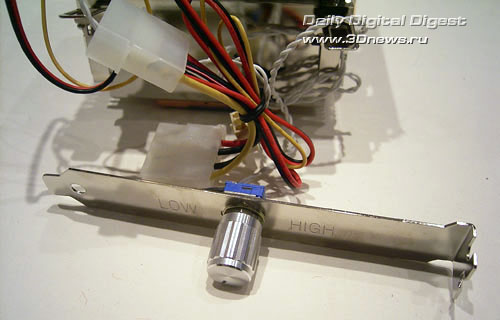
Now a few words on the specifications. First, the cooler weighs 700 g. The fan is 92 mm in diameter (height - 38 mm), rotates at 3800RPM, generates 73.6.7CFM air flow, and does not make noise more than 46.0 dBa. The value 46 dBa is a bit too much, but if the user reduces the speed to the minimum possible (1000 RPM), then the noise level will drop to 14.0 dBA (i.e., below the audibility level!). At the same time, the air flow drops to 18.0 CFM. The practical tests showed the "honesty" of declared specifications: as the rotational speed drops below 1300 RPM, the fan runs absolutely noiselessly and if it exceeds 3000 RPM even confirmed overclockers will close their ears! 
It should be noted that the cooler base is of ideal processing quality: We see a 100% mirror surface, which guarantees the maximum contact with the processor's heat spreader. However, that does not prevent from using thermo paste because very often CPU heat spreaders turn out to be faulty (both for AMD and Intel). 
In general, the cooler produced a really positive impression, but its price seemed too high to us (30$). Pros:
Cons:
Scythe KatanaHere is another product by Scythe whose design basically replicates the previous. In particular, the cooler has an aluminum radiator to which energy is passed from the base with heat pipes. The box with the cooler is very compact and does not reveal the latent capabilities of Scythe Katana. 
The number of components is great enough, and some of them are similar to what we saw in Ninja+ and Kamaboko-Z. In particular, the scheme of fastening on LGA775 in fact coincides. 
However, during installation we came up against one problem - on one component the mounting hole is not completely drilled. Actually, we coped with that quite quickly. 
Now let's look at the cooler. 
In general, it is very similar to VapoChill Micro. On the front, there is a 92 mm fan that rotates at 2000 rpm. At this speed the noise level is 25.0 dBA, and the air flow is 35.12 CFM. The cooler operates quietly enough and its noise is felt only when all the fans in the system are disabled. 
The cooler's overall dimensions are: the length is 98 mm, width - 96 mm, and the height 130 mm. The cooler weighs 300 g. 
As we already said, the heat from the base is passed to the radiator with four heat pipes. The radiator itself consists of a large number of aluminum plates of quite amusing shape. 
The upper plate is polished and there is an embossed Scythe logo: 
Of note is the ideal processing quality of the cooler base: 
While installing the cooler on a motherboard we did not come across any issues or conflicts. 
In conclusion, we note that the retail price matches the quality of the cooler and equals 25$. Pros:
Cons:
Scythe Samurai-ZThe previous version of Samurai cooler was released in two modifications. In particular, a year ago we tested Samurai revision B which we didn't like for its complicacy of installation and low efficiency of cooling LGA775-processors. The new reincarnation of Samurai-Z offers an absolutely new design using again the same heat pipes. 
Besides, the functional diagram of fastening has been changed, and the focus was made on the ease of installation. We can say that engineers at Scythe have succeeded in that: the installation is very simple and takes just a few seconds. 
By the way, the fastening scheme fully coincides with that of Scythe Mine. 
Note that the lateral plates of the radiator are polished and have a Scythe logo: 
The cooler's overall dimensions are: the length is 128 mm, width - 85 mm, and the height 98 mm. The cooler weighs 360 g. 

On the radiator, there is a 92 mm fan of 2000 rpm rotation speed. At this speed the noise level is 23.5 dBA (in practice the cooler runs almost noiselessly!), and the air flow is 32.4 CFM. 
The processing quality of the cooler is good enough but is far from the mirror surface of the base in Katana and Kamaboko-Z coolers: 
In conclusion, we note that the retail price is about 30$. Pros:
Cons:
Cooler Master Hyper L3The cooler is packed in a cardboard box with large transparent windows: 
There is nothing else inside but the cooler itself. Unlike most of the tested coolers, the model Hyper L3 does not have a universal fastener and is aimed solely at the LGA775 platform. That is why the company engineers decided not to invent a new type of fastener but simply replicated the latches of the boxed cooler. 
The cooler itself looks like this: 
In the design of the cooler there are used 3 heat pipes which pass heat from the base to the upper part of the radiator fins. The radiator fins are installed straight on the base. Therefore, the overall efficiency of the radiator goes up. 
The cooler's overall dimensions are: length 112 mm, width 90 mm, and height 41 mm. That is, it is very compact and does not create issues upon installation. 
Now a few words on the specifications. First, the cooler weighs 423 g. The fan is 92 mm in diameter, rotates at 2800RPM, generates 49.56.7CFM air flow, and does not make noise more than 18 dBa. 
In practice, the noise of the cooler is quite noticeable and definitely does not match the declared noiseless operation (18 dBa). By the way, you won't be able to connect Cooler Master Hyper L3 to some speed regulators (because of the 4-pin connector), so the major way to change the speed is use of respective features of the motherboard. Note that the cooler base is of quite decent processing quality. Also note the pre-applied layer of thermal interface. The efficiency of this thermo paste is better than the popular KPT-8. 
On the whole, the cooler produced a really positive impression, but only until we found out the retail price. The price is about $40, which is a bit too much for a product of such a class. Pros:
Cons:
|
|
|||||